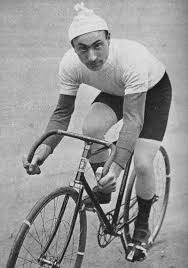Cyrille Van Hauwaert (1883-1974) was one of the most successful Belgian cyclists of the pre-WWI era.
 Van Hauwaert’s story reads like a folk legend. A big, strong Flemish farm boy who didn’t speak French, he arrived at the office of La Française cycling team’s directeur sportif, Pierre Pierrard, just two days before the 1907 Paris-Roubaix race. In his hand was a letter of recommendation from a regional agent of the bicycle manufacturer sponsoring the team. Despite the late hour and the lack of available pacemakers to support him, Pierrard took a chance, ordering the mechanics to set up a bicycle for the young Belgian.
Van Hauwaert’s story reads like a folk legend. A big, strong Flemish farm boy who didn’t speak French, he arrived at the office of La Française cycling team’s directeur sportif, Pierre Pierrard, just two days before the 1907 Paris-Roubaix race. In his hand was a letter of recommendation from a regional agent of the bicycle manufacturer sponsoring the team. Despite the late hour and the lack of available pacemakers to support him, Pierrard took a chance, ordering the mechanics to set up a bicycle for the young Belgian.
With instructions to keep up with the pack as long as he could, Van Hauwaert exceeded expectations. In a stunning debut, he finished second, just behind the winner, Georges Passerieu.
Van Hauwaert’s next race was the prestigious Bordeaux-Paris, where he emerged as the top rider, cementing his reputation as a powerful competitor. The following year, 1908, would prove even more successful for Van Hauwaert. He won both Milano-Sanremo and Paris-Roubaix, and
as part of his intense preparation, he rode from Belgium to Italy by bicycle, viewing the journey as a perfect training ride.
Over the next several years, Van Hauwaert consistently finished among the top five in both Paris-Roubaix and Milano-Sanremo, proving his endurance and strength in every race. His resilience also carried over into the Tour de France, where he competed frequently and achieved his best finish in 1909, placing fifth overall. He also won the first stage, a grueling 272 km from Paris to Roubaix, making him the first Belgian cyclist to lead the general classification in the Tour.
Though he retired from competitive racing during WWI, Van Hauwaert’s connection to cycling never waned. He founded the “Cycles Van Hauwaert” bicycle manufacturing company, keeping his legacy alive in the world of cycling long after his racing days were over.